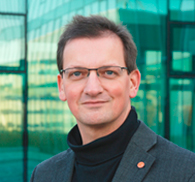 Dr. Sebastian Leidel
Dr. Sebastian Leidel
Sebastian Leidel received his Diplom in Cell Biology, Molecular Biology and Ecology from Heidelberg University in 2001. As an undergraduate, he obtained research experience with Dr. Tony Hyman at the EMBL, Heidelberg and performed his master thesis with Dr. Hans Schöler at the University of Pennsylvania. Subsequently, he entered the graduate program at the Swiss Institute for Experimental Cancer Research (ISREC) in Lausanne, where he worked with Dr. Pierre Gönczy to characterize the SAS proteins and their role for centrosome duplication in Caenorhabditis elegans and human cells. He received his Ph.D. in Life Sciences from the University of Lausanne in 2005.
To expand toward biochemistry Dr. Leidel joined the laboratory of Dr. Matthias Peter at the Institute of Biochemistry of the ETH Zurich for his postdoctoral work in 2005. There he characterized Ubiquitin related modifier 1 (Urm1). Surprisingly, he found that the main function of the URM1 pathway is 2-thiolation of cytoplasmic tRNA and not protein conjugation. This finding placed Urm1 at the branchpoint of evolution between ubiquitin-like proteins and bacterial sulfur-carriers. He was promoted to become a lecturer at the Institute of Biochemistry in 2008.
Dr. Leidel became an independent Max Planck Research Groupleader at the Max Planck Institute for Molecular Biomedicine in Münster in 2010. His goal is to understand the in vivo roles and regulation of RNA modifications. Importantly, posttranscriptional chemical modifications of RNA constitute an underappreciated layer of epigenetic regulation that may facilitate cellular responses to stress. Finally, a growing number of human pathologies have been linked to defects in RNA modifications emphasizing their importance during development and in the context of disease. The Leidel lab combines numerous state-of-the-art methods like RNASeq, RNA mass spectrometry and ribosome profiling and applies those in different organisms as an unbiased systems approach.

